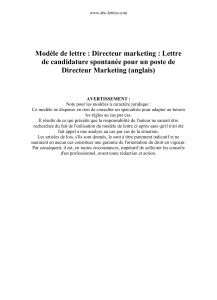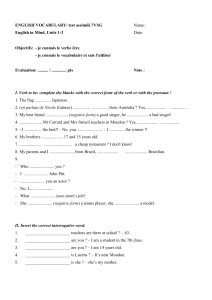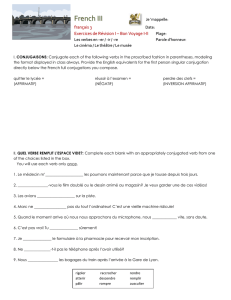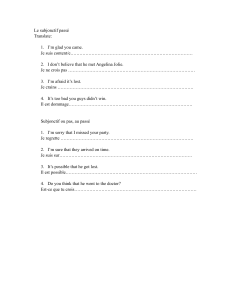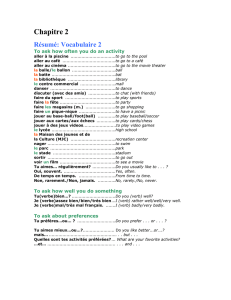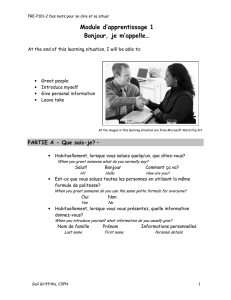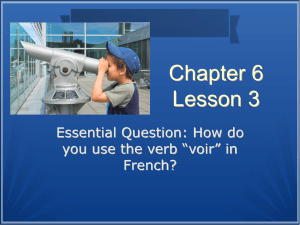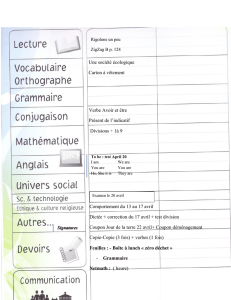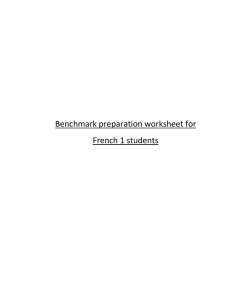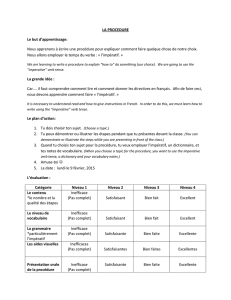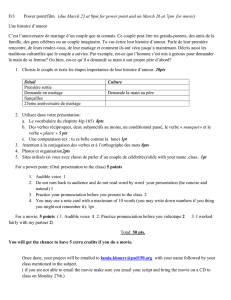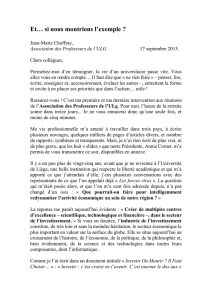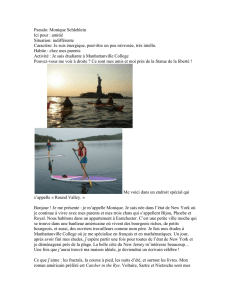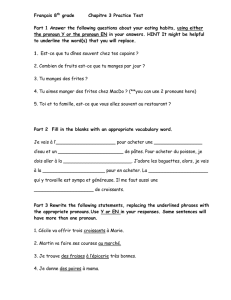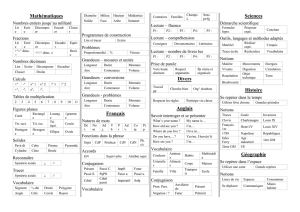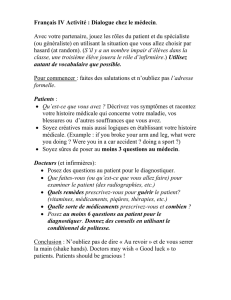Bonjour, je m`appelle…
publicité
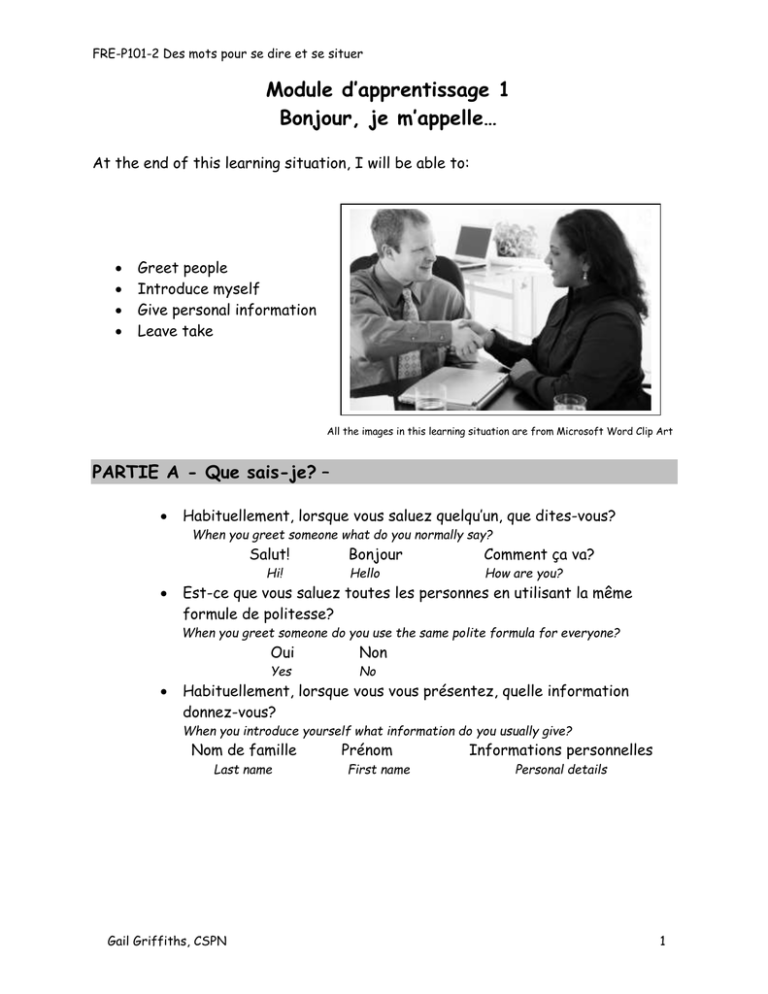
FRE-P101-2 Des mots pour se dire et se situer Module d’apprentissage 1 Bonjour, je m’appelle… At the end of this learning situation, I will be able to: Greet people Introduce myself Give personal information Leave take All the images in this learning situation are from Microsoft Word Clip Art PARTIE A - Que sais-je? – Habituellement, lorsque vous saluez quelqu’un, que dites-vous? When you greet someone what do you normally say? Salut! Hi! Bonjour Hello Comment ça va? How are you? Est-ce que vous saluez toutes les personnes en utilisant la même formule de politesse? When you greet someone do you use the same polite formula for everyone? Oui Yes Non No Habituellement, lorsque vous vous présentez, quelle information donnez-vous? When you introduce yourself what information do you usually give? Nom de famille Last name Gail Griffiths, CSPN Prénom First name Informations personnelles Personal details 1 FRE-P101-2 Des mots pour se dire et se situer PARTIE B J’écoute Situation de vie My Strategies Use the context to guess the meaning of a word Pick out words or phrases that I already know Deux personnages de dessins animés se rencontrent et se présentent. Two cartoon characters meet and introduce themselves. Regardez le vidéo clip sur le site Internet http://www.youtube.com/watch?v=waoZzjwbr-I afin d’écouter leur conversation. Watch the video clip on the Website to listen to their conversation. Ils ont dit… My Strategy Use your French/English dictionary Voici des mots et des expressions utiles que vous avez entendus lors de la conversation. Associez chacun d’entre eux à son équivalent en anglais. Here are some words and expressions that you heard in the conversation. Match each one with the English translation. Je viens du Canada Ça va bien Salut Je m’appelle… Comment ça va? Ça me fait plaisir de te rencontrer Comment tu t’appelles? J’habite à Québec Au revoir À la prochaine ANGLAIS a) Hello b) Good bye c) What’s your name? d) How’s it going? e) Good f) I’m pleased to meet you g) My name is… h) I live in Quebec i) See you again j) I come from Canada Gail Griffiths, CSPN FRANÇAIS _____________________________________ _____________________________________ _____________________________________ _____________________________________ _____________________________________ _____________________________________ _____________________________________ _____________________________________ _____________________________________ _____________________________________ 2 FRE-P101-2 Des mots pour se dire et se situer PARTIE C Je parle… My strategy Take risks C’est maintenant le temps de parler. Pour vous aider avec la prononciation, regardez le vidéo clip sur le site Internet http://www.youtube.com/watch?v=92aQwVUBAYY&feature=related afin de suivre une mini leçon sur la façon de prononcer les mots en français. *Veuillez noter que cette leçon est seulement un survol général du sujet. Parce qu’elle est présentée par une anglophone, la prononciation n’est pas toujours exacte. It is now time to speak. To help you with your pronunciation, watch the video clip on the Website for a mini lesson on French pronunciation. *Please note that this lesson is only general overview of the subject. Because it is presented by an Anglophone, the pronunciation is not always accurate. Maintenant exercez-vous à prononcer des formules de politesse utilisées pour saluer, se présenter et prendre congé. Regardez le vidéo clip sur le site Internet http://www.youtube.com/watch?v=LF5JwkJZh-Y et répétez les mots et expressions en français. Now practice saying the polite formulas used to greet, to introduce yourself and to take leave of people. Watch the video clip on the Website and repeat the French words and expressions. Gail Griffiths, CSPN 3 FRE-P101-2 Des mots pour se dire et se situer Je me souviens My strategy Use your French/English dictionary Voici des mots et des expressions utiles que vous avez répétés. Vous en souvenezvous? Associez chacun d’entre eux à son équivalent en anglais. Here are some useful words and expressions that you repeated. Do you remember them? Match each one with the English translation. Je vous en prie Bonne nuit Bonjour Je suis Américain Bien et vous? Enchanté Bonjour Je m’appelle Au revoir Comment vous appelez-vous? À bientôt Merci Bon après-midi Bonsoir Comment ça va? S’il vous plaît ANGLAIS a) Hello b) Good bye c) Good morning d) Good afternoon e) Good night f) Good evening g) How are you? h) Very well and you? i) Please j) Thank you k) You are welcome l) See you later m) It’s nice to meet you n) What is your name? o) My name is… p) I am American FRANÇAIS ____________________________________ ____________________________________ ____________________________________ ____________________________________ ____________________________________ ____________________________________ ____________________________________ ____________________________________ ____________________________________ ____________________________________ ____________________________________ ____________________________________ ____________________________________ ____________________________________ ____________________________________ ____________________________________ Maintenant regardez le vidéo clip sur le site Internet http://www.youtube.com/watch?v=LF5JwkJZh-Y de nouveau et vérifiez vos réponses. Watch the video clip on the Website again and check your answers. Gail Griffiths, CSPN 4 FRE-P101-2 Des mots pour se dire et se situer PARTIE D Je Découvre Vous avez probablement remarqué qu’il y a différentes façons de saluer les gens et de prendre congé. Regardez le vidéo clip sur le site Internet http://www.youtube.com/watch?v=lhUUXZxglG4&feature=relmfu afin d’avoir une explication. You probably noticed that there are many different ways to greet and to take leave of people. Watch the video clip on the Website for an explanation. EXERCICE A Utiliseriez-vous Salut ou Bonjour dans les situations suivantes? Would you use Salut or Bonjour in the following situations? SITUATION Vous rencontrez votre enseignant Vous rencontrez un enfant Vous rencontrez votre patron Vous rencontrez un ami Vous rencontrez un camarade de classe pour la première fois SALUTATION _______________________________ _______________________________ _______________________________ _______________________________ _______________________________ JE DÉCOUVRE LA CULTURE La Bise La bise means kiss: French family and friends exchange kisses on both cheeks when greeting and leave-taking. For more details on when and how to do “la bise” go to this Website. http://www.youtube.com/watch?v=QAREHu3tW7E Gail Griffiths, CSPN 5 FRE-P101-2 Des mots pour se dire et se situer PARTIE E J’observe My strategy Consult reference tools such as: dictionaries, grammar books, verb conjugation tables, Websites. Pour être capable d’agir avec compétence dans cette situation de vie courante, vous devez connaître les notions suivantes : To be able to competently handle this situation in real life, you will need to know the following concepts: Personal (Subject) pronouns The verb : être (to be) in the present indicative The verb avoir (to have) in the present indicative The verb: venir de (to come from) in the present indicative The verb: habiter (to live) in the present indicative Étudiez-les, puis utilisez-les souvent! Study them and use them often! 1 Personal (Subject) pronouns Just as in English, French personal or subject pronouns are words used to replace nouns (people, places, things, ideas or qualities). Similarly, they are also given a person and a number (singular or plural) as shown in the table below: st 1 person 2nd person 3rd person SINGULAR je tu (familiar) il, elle, on (general) ENGLISH I you he, she, it, we PLURAL nous vous (formal) ils, elles ENGLISH we you they Regardez le vidéo clip sur le site Internet http://www.youtube.com/watch?v=G3NSIuYpDmc et lisez les informations à la page suivante afin d’avoir une explication. Watch the video clip on the Website and read the information on the following page for an explanation. Gail Griffiths, CSPN 6 FRE-P101-2 Des mots pour se dire et se situer Je (1st person singular) Unlike the English pronoun “I”, the pronoun je is capitalized only when it begins a sentence. Je becomes j’ before a vowel or vowel sound: Je mange. (I eat.) J’aime manger. (I like to eat.) Tu (2nd person singular) Tu is the singular form used to address a friend, relative, child or pet. It is the familiar form of “you”. Tu es mon ami. (You are my friend.) Il (3rd person singular) Il (he) marks singular when the person or thing referred to is masculine.* Pierre est ici. Il est ici. (Pierre is here. He is here.) Le bureau est brun. Il est brun. (The desk is brown. It is brown) *In French, there is no neuter pronoun (“it” in English). That means that things are either masculine or feminine - Il or elle (This is known as “gender” and will be further discussed in a later unit). Elle (3rd person singular) Elle (she) marks singular when the person or thing referred to is feminine.* Marie est ici. Elle est ici. (Marie is here. She is here.) La chaise est bleue. Elle est bleue. (The chair is blue. It is blue.) *In French, there is no neuter pronoun (“it” in English). That means that things are either masculine or feminine - Il or elle (This is known as “gender” and will be further discussed in a later unit). On (3rd person singular) On is a pronoun used to represent people in general. It is often used in place of nous (we). On part. (We’re leaving.) Nous (1st person plural) Nous means we in English and is used when speaking about yourself and another or yourself and others. Gail Griffiths, CSPN 7 FRE-P101-2 Des mots pour se dire et se situer Vous (2nd person plural) Vous is used in the singular to show respect to an older person or when speaking to someone you don’t know very well. Ex: Talking to someone you don’t know very well: Pouvez-vous m’aider? (Can you help me?) Vous is used in the plural form when speaking to more than one person, regardless of the degree of familiarity. Ex: Talking to more than one person: Vous êtes tous ici. (You are all here.) Ils (3rd person plural) Ils marks plural when all the people are men (Pierre et Jacques), when the people are a combined group of men and women (Jacques et Marie), or when things are masculine plural (This is known as “gender” and will be further discussed in a later unit). Ex: Jacques et Marie s’amusent, ils rient. Elles (3rd person plural) Elles marks plural when all the people are women (ex. Anne et Marie) or when things are feminine plural (This is known as “gender” and will be further discussed in a later unit). Ex: Anne et Marie vont à Montreal. Elles vont au cinema. EXERCICE A Changez les mots en italique pour un pronom personnel. Change the italicized words to a personal (subject) pronoun. 1. 2. 3. 4. 5. Marie parle français. Pierre chante bien. Georges et André jouent de la guitare. Hélène et Anne étudient. Yvonne et George sont en vacances. ___________________ ___________________ ___________________ ___________________ ___________________ For more personal pronoun practice go to Annex 1 at the end of the unit. Gail Griffiths, CSPN 8 FRE-P101-2 Des mots pour se dire et se situer 2 The verb être (to be) in the present indicative The verb être means to be and is an irregular verb. This means that it does not follow a standard conjugation pattern. ÊTRE Je suis Tu es Il est Elle est On est Nous sommes Vous êtes Ils sont Elles sont TO BE I am You are He is She is We are (people in general) We are You are They are They are Regardez le vidéo clip sur le site Internet http://www.youtube.com/watch?v=404yNORWcb0 afin de mette en pratique la prononciation et la conjugaison. Watch the video clip on the Web site to practice the pronunciation and conjugation. EXERCICE B Remplissez les espaces avec la bonne forme du verbe être. Fill in the blanks with the correct form of the verb être. 1. Line et Claire _______________étudiantes. 2. Je _______________malade. 3. Lisa _______________patiente. 4. Nous _______________en vacances. 5. Guy et Martin _______________contents. 6. Tu _______________heureux. 7. Jacques _______________gentil. 8. Vous _______________électricien. 9. On _______________dans la classe. 10. Vous _______________à l’épicerie. Gail Griffiths, CSPN 9 FRE-P101-2 Des mots pour se dire et se situer 3 The verb avoir (to have) in the present indicative The verb avoir means to have and is an irregular verb. This means that it does not follow a standard conjugation pattern. AVOIR J’ai Tu as Il a Elle a On a Nous avons Vous avez Ils ont Elles ont TO HAVE I am You have He has She has We have (people in general) We have You have They have They have Regardez le vidéo clip sur le site Internet http://www.youtube.com/watch?v=L17gDEjm8Q0 afin de mettre en pratique la prononciation et la conjugaison. Go to the Website to practice the pronunciation and conjugation. *Be careful, there are quite a few instances where French uses Avoir (to have) and English uses être (to be): Français (avoir) English (être) J’ai froid. I am cold. J’ai faim. I am hungry. J’ai soif. I am thirsty. J’ai dix-neuf ans. I am nineteen years old. Did you notice that in French we say: “J’ai dix-neuf ans.” = “I have nineteen years.” NOT: “Je suis dix-neuf ans. ” = “I am nineteen years old.” as we do in English. Gail Griffiths, CSPN 10 FRE-P101-2 Des mots pour se dire et se situer EXERCICE C Remplissez les espaces avec la bonne forme du verbe avoir. Fill in the blanks with the correct form of the verb avoir. 1. Fatima _______________un chien. 2. Les enfants _______________un rhume. 3. J’ _______________une pomme. 4. Vous _______________des enfants. 5. Lisa et Josée _______________un emploi. 6. On _______________un bon prof. 7. Tu ______________du chocolat. 8. Il _______________ une voiture. 9. Nous _______________des problèmes. 10. J’ _______________un chat. For more practice using the verbs avoir and être please go to Annex 2 at the end of the unit. 4 The verb venir de (to come from) in the present indicative In French, when talking about your origins, where you come from, you use the verb venir. Ex: Je viens de l’Asie – I come from Asia Venir is an irregular verb. This means that it does not follow a standard conjugation pattern. To conjugate it, your best tool is a Bescherelle. Go to the table of contents at the end of this book and find the verb (in its infinitive form). Go to that page, and under Indicatif you will see the present form. Regardez le vidéo clip sur le site Internet http://www.youtube.com/watch?v=qRaZc5VnUzg afin de mettre en pratique la prononciation et la conjugaison. Watch video clip on the Website to practice the pronunciation and conjugation. Gail Griffiths, CSPN 11 FRE-P101-2 Des mots pour se dire et se situer EXERCISE D Utilisez un Bescherelle pour remplir le tableau. Conjuguez le verbe VENIR au présent de l’indicatif. Use a Bescherelle to fill in the chart. Conjugate the verb VENIR in the present indicative. VENIR Je Tu Il Elle On Nous Vous Ils Elles EXERCICE E Remplissez les espaces avec la bonne forme du verbe venir. Fill in the blanks with the correct form of the verb venir. 1. 2. 3. 4. 5. 6. 7. 8. 9. 10. Il _______________de Regina. Nous _______________du musée. Ils _______________de la piscine. Vous _______________de la cafétéria. Tu _______________de Paris. Je _______________magasin. Paul _______________du parc. Henri et Hélène _______________du Canada. Nous _______________de la bibliothèque. Maria _______________ d’Ottawa. Gail Griffiths, CSPN 12 FRE-P101-2 Des mots pour se dire et se situer 5 The verb habiter (to live) in the present indicative In French, when talking about where you live, you use the verb habiter. Ex: J’habite à Quebec. – I live in Quebec. Habiter is a regular -ER verb. This means that it follows a standard conjugation pattern. To conjugate it and other regular –ER verbs you take off the –ER ending and add the following endings: -e, -es, -e, -ons, -ez, -ent. *Note that Je changes to j’ before a verb starting with a vowel or a silent h. Regardez le vidéo clip sur le site Internet http://www.youtube.com/watch?v=SWc01OsWVuA afin d’avoir une explication. Watch the video clip on the Website for an explanation. Regardez le vidéo clip sur le site Internet http://www.youtube.com/watch?v=dTl5eydhC3E afin de mettre en pratique la prononciation et la conjugaison du verbe habiter. Watch the video clip on the Website to practice the pronunciation and conjugation of the verb habiter. EXERCICE F Conjuguez le verbe HABITER au présent de l’indicatif. Conjugate the verb HABITER in the present indicative. HABITER J’ Tu Il Elle On Nous Vous Ils Elles Gail Griffiths, CSPN 13 FRE-P101-2 Des mots pour se dire et se situer EXERCICE G Maintenant conjuguez les verbes suivants au présent de l’indicatif. Now practice. Conjugate the following verbs in the present indicative. VENIR ÊTRE HABITER AVOIR elles elles elles elles nous nous nous nous on on on on elle elle elle elle ils ils ils ils vous vous vous vous tu tu tu tu il il il il je je j’ j’ Utilisez votre Bescherelle pour vérifier vos réponses. Use your Bescherelle to check your answers. Gail Griffiths, CSPN 14 FRE-P101-2 Des mots pour se dire et se situer PARTIE F Je passe à l’action Utilisez vos compétences acquises pour réaliser cette activité. Use your acquired skills to carry out this activity. Des choses à dire My strategies Consult reference tools such as: dictionaries, grammar books, verb conjugation tables, the Website. Copy words or groups of words. Reread and correct my writing. Imaginez que vous vous êtes inscrit à un cours de français, niveau débutant. Aujourd’hui est votre premier cours. 1. Vous devez saluer vos camarades de classe. 2. Vous devez vous présenter à la classe. 3. Ensuite, choisissez au moins trois faits intéressants de votre vie que vous aimeriez partager avec vos camarades de classe afin de les aider à vous connaître un peu plus. Soyez créatif! (Ex: pays d’origine, l’endroit où vous habitez, âge, situation personnelle, enfants, animaux domestiques, etc.) . 4. Finalement, utilisez une formule d’usage pour prendre congé. Utilisez le gabarit suivant pour vous aider à vous préparer. Imagine that you have signed up for a beginner French class. Today is your first class. 1. You must greet your classmates 2. You must introduce yourself to the class. 3. Then, choose at least three interesting facts about your life that you would like to share with your classmates to help them get to know you better. Be creative! (Ex: country of origin, where you live, age, family situation, children, pets, etc.) 4. Finally, use a polite leave-taking formula. Use the following template to help you prepare. Gail Griffiths, CSPN 15 FRE-P101-2 Des mots pour se dire et se situer Ma présentation orale. 1. Salutation _________________________________________________ 2. Vous vous présentez ___________________________________________ 3. Suggestions pour vos faits intéressants (en choisir au moins trois): Pays d’origine ______________________________________ Je + verbe venir de + … L’endroit où vous habitez ________________________________ J’ + verbe habiter + … Âge Situation personnelle Enfants Animaux domestiques ______________________________________ Je + verbe avoir + … ___________________________________ Je + verbe être + … ________________________________________ Je + verbe avoir + … ____________________________________ Je + verbe avoir + 4. Formule d’usage pour prendre congé : _____________________________ Relisez votre présentation et faites les corrections nécessaires. Reread your presentation and make any necessary corrections. Gail Griffiths, CSPN 16 FRE-P101-2 Des mots pour se dire et se situer De vive voix My strategies Take risks Use nonverbal language Présentez oralement votre travail à la classe ou à votre enseignant. Orally present your work to the class or to your teacher. PARTIE G Je sais… Écrivez cinq mots ou expressions que vous avez appris dans cette situation d’apprentissage et que vous utiliserez de nouveau. Write five words or expressions that you have learned in this learning situation and that you will use again. _____________________________________________________________ _____________________________________________________________ _____________________________________________________________ _____________________________________________________________ _____________________________________________________________ 2. Avez-vous atteint vos buts? Êtes-vous satisfait de votre apprentissage? Cochez la case appropriée. Did you meet your goals? Are you satisfied with what you have learned? Check the appropriate box. Partie B J’écoute Partie C Je parle Partie D Je découvre Partie E J’observe Partie F Je passe à l’action peu bien très bien Gail Griffiths, CSPN 17 FRE-P101-2 Des mots pour se dire et se situer Annexe 1 Choisir le pronom personnel qui remplace les noms et/ou les mots entre parenthèses. Choose the personal (subject) pronoun that replaces the names and/or words in parentheses. Je Tu Il Elle On Nous Vous Ils Elles 1. (Marie et Julie)________________ regardent la télévision. 2. (Jean et Julie) _______________sont à la maison le dimanche. 3. (Toi et Michel) _______________mangez au restaurant. 4. (Toi et moi)_______________étudions tous les jours. 5. (Moi)_______________suis étudiant(e). 6. (M. et Mme Jones) _______________habitent à Paris 7. (Marie et Monique) _______________sont en vacances. 8. (Janine)_______________a un livre. 9. (Jacques)_______________est malade. 10. (Suzanne)_______________est à l’école. 11. (Jean)______________ aime jouer. 12. (Toi) _______________ es malade. 13. (M. St-Arnaud) _______________est le directeur. 14. (Toi et moi) _______________ avons le même âge. 15. (Jean et Julie) _______________ sont de Montréal. Gail Griffiths, CSPN 18 FRE-P101-2 Des mots pour se dire et se situer Annexe 2 Conjuguez les verbes être ou avoir au présent de l’indicatif dans les phrases suivantes. Conjugate the verbs être or avoir using the présent de l’indicatif in the following sentences. 1. Nous _______________à la pharmacie. 2. J’ _______________froid. 3. Vous _______________gentil. 4. Elles _______________un rendez-vous. 5. Guy et Martin _______________étudiants. 6. Elle _______________trois enfants. 7. Nous _______________en vacances. 8. Vous _______________une grippe. 9. Il _______________charmant. 10. Nous _______________un chat. 11. Vous _______________électricien. 12. Vous _______________chaud. 13. On _______________dans la classe. 14. Je _______________malade. 15. Tu _______________patient. 16. Tu _______________médecin. 17. Marie et Josée _______________au cinéma. 18. Josée _______________un chien. 19. Les enfants _______________un rhume. 20. J’ _______________une pomme. 21. Je _______________en vacances. 22. Tu _______________malade. 23. On _______________de bons cours. 24. Nous _______________en classe. 25. On _______________heureux. Gail Griffiths, CSPN 19
